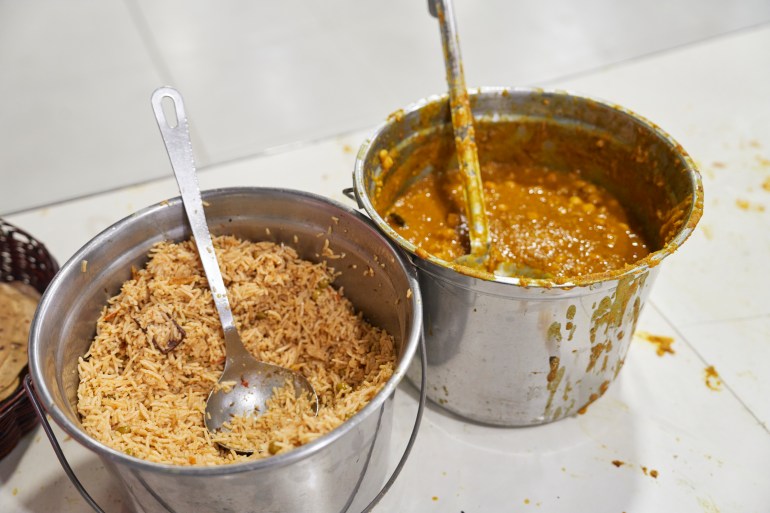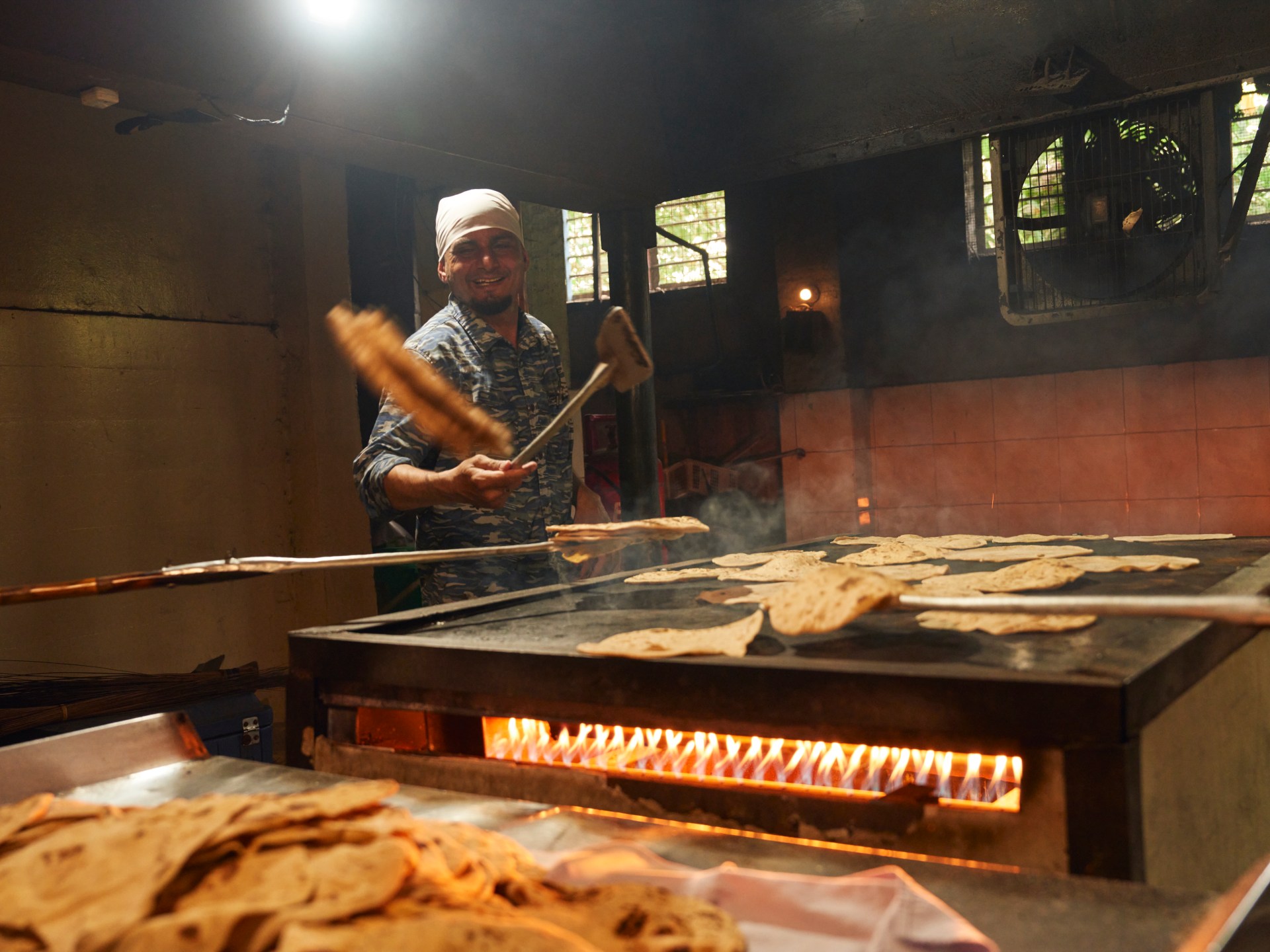The Sikh kitchen that feeds Manila’s moneylenders | Fork the System
Manila, Philippines – “Don’t treat this like a full dinner. Only take small portions,” a mother warns her son as he reaches for a second helping of zarda – saffron-hued, sweetened rice topped with heaps of raisins and cashews – on the crowded buffet-style table at the Khalsa Diwan Temple in Manila. “We must not waste anything.”
I overhear her while standing in line to sample the different varieties of barfi, a dense, milk-based fudge laden with sliced almonds – a popular sweet from the Indian subcontinent. The mother and son are among the 100-plus members of the Metro Manila Sikh community who have gathered here in late August to celebrate the Parkash Utsav of Guru Granth Sahib, a commemoration of the first opening ceremony of Sikhism’s central religious scripture.
It is a busy day for the community kitchen, the langar. Dozens of volunteers snake their way through the crowd to serve rotis, fresh off the tandoor. Sitting cross-legged in rows across the main hall of the gurdwara, or Sikh place of worship, attendees dip roti into shahi paneer, a creamy curry with pockets of hard cheese, or happily spoon up the gajar ka halwa, a fragrant carrot pudding, neatly portioned off inside large steel trays.
Surveying the room, I momentarily forget that I am in the Philippines.
The birth – and longevity – of moneylending in Manila
Founded in 1929 by a small group of Punjabi migrants, Khalsa Diwan Temple is Manila’s oldest gurdwara. It marked the beginning of a budding Sikh community in the Philippines.
Punjabi migrants, who form the bulk of the India diaspora population in the Philippines (nearly 82 percent), began to trickle into the country in the 1920s, explains Joefe Santarita, a professor at the Asian Center at the University of the Philippines Diliman. First, they tried their hand at farming, then moved to small-scale businesses.
“From that experience”, Santarita says, “they realised Filipino families needed money.” A shift towards moneylending likely happened during World War II when there was an urgent need for capital among micro-entrepreneurs in rural areas, he adds.
While financial inclusion in the Philippines has improved dramatically since then, 44 percent of Filipinos did not have access to a formal bank account as recently as 2021, according to the Philippine central bank, Bangko Sentral ng Pilipinas.
The Punjabi migrants tapped into a consistent demand from this unbanked community, offering loans for small-scale entrepreneurs or micro-enterprises – and not asking for documents or collateral. To compensate, loans are offered at a hefty 20 percent interest.
Today, the moneylending community is interwoven throughout the Philippines, even if it largely sits on the fringes of the law. Moneylenders are now an integral part of the country’s informal economy, zipping through neighbourhoods on their motorbikes to solicit new clients and service existing ones. They operate on an informal basis without any permits, often cultivating new clients by offering various goods, such as small electrical appliances, on instalments.
The returns are so lucrative, many Indian migrants, mostly from the state of Punjab, move to the Philippines to pursue moneylending.
However, no business happens at the gurdwara, which functions as an anchor of the Sikh community. Here, the moneylenders leave their work behind to perform sewa (“selfless service” in Punjabi). One way is to help keep the huge community kitchen running as a place where anyone, regardless of religious denomination, can get a free meal.
![The main dining hall at the Khalsa Diwan Sikh Temple in Manila, Philippines [Sonny Thakur/Al Jazeera]](https://www.aljazeera.com/wp-content/uploads/2024/01/STST_Fork_0169-Manila-moneylenders-Sonny-Thukar-1705945654.jpg?w=770&resize=770%2C513)
When I visit the gurdwara again on a February afternoon, the langar is quiet. A small group of Indian medical students sits cross-legged, dipping thick whole wheat chapati into a mashed masoor dal. The dal is simple but flavourful, spiced with heaps of onion, garlic and red chilli powder. The food at the gurdwara is different from back home in their state of Andhra Pradesh on India’s southeastern coast, but they are enjoying it. The quality, they say, keeps them coming back.
“It’s also free,” Vikram Seetak, the temple’s head, reminds me when I tell him the students love his food. Seetak has been working in the gurdwara kitchen since 1999. Unlike the majority of his peers at the gurdwara, Seetak did not go into moneylending. After moving to Manila from a small town near Jalandhar in eastern Punjab, where he worked at his family’s mithai (sweets) shop, he took up a job at the nearby South Asian grocery store. After a few months, he became a full-time cook at Khalsa Diwan.
![The fresh produce used for meals at the Khalsa Diwan Skih Temple Manila is provided by community volunteers [Sonny Thakur/Al Jazeera]](https://www.aljazeera.com/wp-content/uploads/2024/01/STST_Fork_0013-Manila-moneylenders-Sonny-Thukar-1705944549.jpg?w=770&resize=770%2C513)
Seetak now heads a team of eight: a mix of Indian-origin and Filipino cooks, one of whom has worked with him for the past 20 years. He likes being in charge of the kitchen. “I have to do the mixing of the spices myself,” he tells me while straining a thick batter of gram flour and sugar syrup into a large deg, a thick aluminium pot.
He is making badana, more commonly known as boondi – bite-sized, sharply sweetened, fluorescent orange balls – in preparation for the weekend’s festivities. In addition to catering a wedding at the gurdwara, Seetak and his team are gearing up to celebrate the birth, in 1630, of the seventh Sikh guru, Guru Har Rai.
![Bikram, who runs the kitchen at the Khalsa Diwan Sikh Temple in Manila, watches over the last batch of food from the morning’s cook. [Sonny Thakur/Al Jazeera]](https://www.aljazeera.com/wp-content/uploads/2024/01/STST_Fork_0051-Manila-moneylenders-Sonny-Thukar.-1705944996.jpg?w=770&resize=770%2C513)
By late afternoon, the gurdwara is teeming with volunteers preparing food. They chop tomatoes and onions and sort heaps of spinach to prepare a gurdwara staple: palak pakoray (spinach pakora), which is spinach leaves dipped in a gram flour batter, spiced with roasted coriander seeds and red chilli powder and then fried. There will also be vegetarian “mutton”.
“It has to be a full vegetarian menu,” Seetak says in response to my quizzical look. “So we get a mutton substitute made of soybean.”
While Sikhism does not mandate vegetarianism, all gurdwaras serve only vegetarian cuisine to accommodate the dietary restrictions of people from different faiths as well as members of their own community. Even in Manila, some Sikhs choose to be vegetarian in their homes despite the predominantly omnivorous culture of the Philippines.

Inside the gurdwara office, community volunteer Jagjit Singh, a first-generation Indian Filipina, is standing with the secretary at a laptop reviewing the ingredients they need to buy to prepare pancit, Filipino-style noodles. “Sesame oil, cauliflower, carrots, calamansi, Baguio beans,” she narrates in fluent Tagalog. Because pancit is typically prepared with sliced meat or seafood, the meat substitute will be a vegetarian tapa (jerky), also made with soybeans.
A changing Indian food culture in the Philippines
Singh was born and raised in Manila and now lives with her husband, Shomkor, a Sikh moneylender, in Cavite, a nearby province to the south. Unlike many of her Sikh community members, Singh is a Philippine citizen and firmly identifies as an Indian Filipina. Her father moved to the Philippines from eastern Punjab at the age of five with his parents. Both Singh’s father and grandfather became moneylenders.
“I actually miss Filipino food when I go to India,” Singh tells me. “We like to have a mix of both at home.”
In the morning, she and Shomkor start with a Punjabi-style breakfast, such as aloo poori, a bright and spicy potato curry with puffy, deep-fried bread. For lunch, they switch to Filipino food: adobo, menudo or mechado – rich, Philippine-style stews prepared with meat. And in the evenings, it’s a toss-up.
Singh and her husband are omnivores. “Even though my husband took Amrit [an initiation ceremony that comprises one of Sikhism’s four religious rites], he likes to eat meat,” she says, adding that he “actually prepares Filipino dishes quite well”.
The practice of vegetarianism after taking Amrit varies. Some sects are vehemently against eating meat and eggs while others are not.
Manor Singh, another temple member and moneylender, and his wife are strict vegetarians. Originally from Jalandhar in eastern Punjab, Manor Singh followed his uncle in 1999 to Manila, where he got his start in moneylending. Despite having lived in the Philippines for more than 20 years, Manor and his wife eat vegetarian food. This can include everything from cauliflower and peas in a spiced tomato-onion base to kadhi chawal, lightly spiced gram flour fritters nestled in a turmeric-hued yoghurt curry.
![A large pot of saag simmers as a volunteer uses a large drill to stir the dish thoroughly [Sonny Thakur/Al Jazeera]](https://www.aljazeera.com/wp-content/uploads/2024/01/STST_Fork_0031Manila-moneylenders-Sonny-Thukar.-1705944702.jpg?w=770&resize=770%2C513)
In what would be the winter in Punjab, the Singhs enjoy makki ki roti (stiff roti made with cornmeal) paired with sarson ka saag (slow-cooked mustard greens and spinach topped with sliced garlic tempered in ghee).
They are able to find all the necessary spices at a South Asian grocery, which has six locations across metro Manila. Before the chain opened, Manor Singh remembers the owner selling spices directly from his van outside the gurdwara. Over the years, many South Asian grocery stores have popped up in the neighbourhood.
“Oh, you get everything in the Philippines!” says Ritu Wasu, who runs the Indian restaurant Harishi with her husband and daughter. She sits in the gurdwara office with her friend who runs a small Indian catering business.
For the past five years, Harishi has been serving up a mix of North and South Indian cuisine to a clientele of Indians and Filipinos. “By the time we opened the restaurant, Filipinos were already familiar with Indian food. They especially ask for chicken biryani,” she tells me.
Some speculate that biryani’s popularity in the Philippines can be attributed to Filipinos’ exposure to Indian food while working in Gulf states. “They go to Saudi Arabia and get a taste of biryani and come looking for it back in the Philippines,” a community member explains.
![Fried pakodas from the Khalsa Diwan Sikh Temple kitchen in Manila, Philippines A large pot of saag simmers as a volunteer uses a large drill to stir the dish thoroughly [Sonny Thakur/Al Jazeera]](https://www.aljazeera.com/wp-content/uploads/2024/01/STST_Fork_0043-Manila-moneylenders-Sonny-Thukar.-1705944872.jpg?w=770&resize=770%2C513)
Chicken and rice are a popular pairing in the Philippines. What better introduction to South Asian food than richly spiced chicken layered into fluffy basmati rice?
“Filipinos have come to love Indian food,” Santarita says.
Acceptance and assimilation
Despite being a common fixture for almost a century, the Punjabi moneylending community is still viewed by some with a level of suspicion. Although the gurdwara community members identify themselves as “Bumbays” (derived from the city Mumbai) or “5-6” (“you take five, pay back six” with interest), both are considered largely derogatory terms in the rest of the Philippines.
In 2017, then-Philippine President Rodrigo Duterte called for the arrest of “Bumbay” moneylenders. Opinion pieces and editorials calling for an end to “Bumbay loan sharks” also began to appear in major newspapers around the same time.
Filipino children, meanwhile, have always grown up hearing “Behave, or I’ll call the 5-6!”
Jagjit Singh, who feels well-integrated into the Philippines, believes there has been a shift in attitude in recent years. “It’s not like that any more. Now children will instead tell parents they will send the Bumbays after them. … There is no longer that fear of us,” she says.
Some claim that Duterte’s campaign against the 5-6 was successful, in large part due to the launch of a competing lending scheme by the government’s Department of Trade and Industry and the Securities and Exchange Commission’s broader efforts to regulate lending activities rather than carry out wholesale arrests of small-scale moneylenders. Santarita believes Duterte’s orders for arresting “Bumbay loan sharks” was mostly rhetoric.
“It’s difficult to stop the moneylending and from Bumbays conducting business because there is a dire need of capital among customers who are considered unbanked,” Santarita says. In addition to a lack of access to formal bank accounts, borrowing from formal institutions is costly and cumbersome with high collateral and burdensome documentary requirements. The critical function of micro-financing partially helps explain why Indian and Indian-origin moneylenders continue to operate without permits.
![Motorbikes parked outside the Khalsa Diwan Sikh Temple Manila [Sonny Thakur/Al Jazeera]](https://www.aljazeera.com/wp-content/uploads/2024/01/STST_Fork_0168Manila-moneylenders-Sonny-Thukar-1705945526.jpg?w=770&resize=770%2C513)
Due to the high returns of informal moneylending, the scale of migration from Indian Punjab to the Philippines spiked at the turn of the 21st century. In response to many Indian migrants living undocumented in the Philippines from the 1940s to the 1960s, the Philippine government made a strong push to regulate their presence, forcing them to seek residence permits or face deportation.
To avoid being hassled, many Indian migrants, with help from the Indian embassy in Manila, became legal residents, but few have sought citizenship. Out of an estimated 120,000 to 130,000 residents of Indian origin in the Philippines only 5,000 have acquired citizenship.
Manor Singh thinks being a resident is just fine: “We have most of the rights of Filipino citizens. We just can’t vote.”
While the full assimilation of Punjabi immigrants into the Philippines may be slow, more subtle integration is happening, like in the grocery shops. “The arrival of speciality Indian grocery stores and restaurants stemmed out of the need of Indian migrants to be able to source ingredients for their food,” Santarita says.
![A variety of spices in the pantry of the Khalsa Diwan Sikh Temple Manila Fried pakodas from the Khalsa Diwan Sikh Temple kitchen in Manila, Philippines A large pot of saag simmers as a volunteer uses a large drill to stir the dish thoroughly [Sonny Thakur/Al Jazeera]](https://www.aljazeera.com/wp-content/uploads/2024/01/STST_Fork_0070-Manila-moneylenders-Sonny-Thukar.-1705945115.jpg?w=770&resize=770%2C513)
This is also in part due to the larger makeup of the Indian and Indian-Filipino population, which includes wealthy (predominantly Hindu) businessmen from states such as Sindh (now part of Pakistan) who moved to the Philippines after the partition of India and Pakistan in 1947.
Now, you can find South Asian ingredients in mainstream grocery chains, and a growing number of Indian restaurants cater to Filipinos as well as Indian-origin patrons.
Filipino cuisine comes home
There are gradual changes taking place within Indian-origin kitchens as well. While Jagjit Singh wishes more people from her community would embrace Filipino food, Indian migrants have begun to slowly incorporate Filipino cuisine into their meals.
Was it Jagjit’s idea, I ask, to serve Filipino pancit at the langar?
“It was actually ‘the guys’,” she tells me, referring to the committee that manages the gurdwara. “I’m just helping.”
Even Wasu, who generally prefers Indian food, sometimes prepares Filipino dishes at home. “Sometimes I make chop suey or Filipino-style pasta or buko pandan [a popular Filipino dessert of coconut, pandan leaves and sago pearls],” she says. Her children especially enjoy Filipino food, she says, adding: “They are not fussy. They will eat whatever is served.”
Back in the gurdwara kitchen, where preparations for the weekend is in full swing, I ask Seetak what dishes he likes – Filipino or Indian? He shares Wasu’s children’s sentiment: “With food, … you don’t play favourites.”
Check out our Latest News and Follow us at Facebook
Original Source







